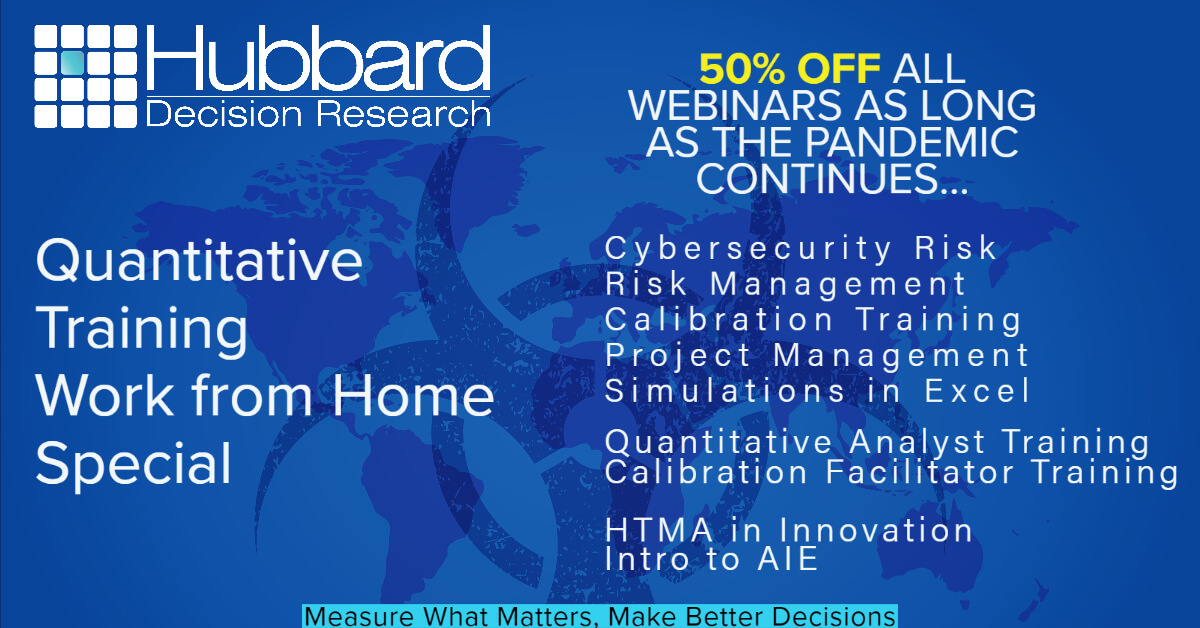
If you haven’t already been sent home to work in the midst of the spreading COVID-19 pandemic, you may very well find yourself there soon. The government is urging anyone who can work remotely to do so for up to eight weeks (or even longer) as the nation tries to flatten the curve of the pandemic’s growth and keep things under control.
To help our fellow exiles, we are offering a special deal: For as long as the crisis continues, get 50% OFF all online training from Hubbard Decision Research. The list of all eligible webinars is below:
introduction to applied information economics - 1 hour
Wednesday, March 18 3:00pm – 4:00pm CDT
Monday, March 30 9:00am – 10:00am CDT
Tuesday, April 14 9:00am – 10:00am CDT
$100 $50
In this one-hour session, you will get an executive overview of methods that show independently, scientifically measured improvements to management forecasts and decisions. This webinar is an excellent means to learn about the key tools and methods of Applied Information Economics, so you can start applying these trusted practices today to grow your organization’s success. Visit the Checkout Page
calibration training - quantify your uncertainty - 3 hours
Thursday, March 19 3:00pm – 6:00pm CDT
Wednesday, April 15 9:00am – 12:00pm CDT
$580 $290
In this 3-hour Calibration webinar, you will learn the techniques behind subjectively assessing the probability of uncertain events and the ranges of uncertain quantities. This is an essential skill for anyone who needs to consider chance in decisions. Participants will see their skills measurably improve during the training with a series of “calibration exams.” Visit the Checkout Page
basic simulations in excel - 3 hours
Monday, March 23 12:00pm – 3:00pm CDT
Wednesday, April 22 3:00pm – 6:00pm CDT
$375 $187.50
Simulations have been shown to measurably improve estimates, but many decision models currently lack this critical element. Learn how to create simulations in native Microsoft Excel that can lead to better decisions in any field. Visit the Checkout Page
calibration facilitator training - 1.5 hours
Tuesday, March 24 3:00pm – 4:30pm CDT
$995 $497.50
The Calibration Facilitator Training webinar and follow-up is for already calibrated people and includes everything that somebody needs to run their own calibration session, including a private follow-up observation occurs when the purchaser gives their first live calibration training in their organization or elsewhere. Note: Calibration Training is a prerequisite. Visit the Checkout Page
intermediate simulations in excel - 3 hours
Thursday, March 26 9:00am – 12:00pm CDT
$375 $187.50
Simulations have been shown to measurably improve estimates, but many decision models currently lack this critical element. Learn how to improve on basic simulations in native Microsoft Excel that can lead to better decisions in any field. Note: Basic Simulations in Excel is highly recommended prior to taking this course. Visit the Checkout Page
the failure of risk management - 2 hours
Friday, March 27 9:00am – 11:00am CDT
$150 $75
The biggest risk to an organization is a failed risk management system. In this 2-hour webinar, based on Doug Hubbard’s ground-breaking book The Failure of Risk Management: Why It’s Broken and How to Fix It (now in its second edition), you’ll learn how risk management today is broken, and how organizations can fix their processes and do a better job protecting themselves from risk through proven quantitative methods. Visit the Checkout Page
applied information economics (aie) analyst training - 9 hours
Monday, March 30 9:00am – 10:00am CDT
Tuesday, March 31 9:00am – 11:00am CDT
Wednesday, April 1 9:00am – 11:00am CDT
Thursday, April 2 9:00am – 11:00am CDT
Friday, April 3 9:00am – 11:00am CDT
$1,450 $725
This series of webinars give the participants hands-on training in the use of Applied Information Economics (AIE), a proven and powerful quantitative analysis method used by Fortune 500 companies, federal and state governments, the U.S. military, and leading multi-national corporations across the globe. It consists of a total of 9 hours of training delivered in five separate modules and teaches participants how to measure any “intangible,” think of risk like an actuary, and look at any portfolio from a risk/return point-of-view. Visit the Checkout Page
how to measure anything in project management - 2 hours
Tuesday, March 31 2:00pm – 4:00pm CDT
Friday, April 17 9:00am – 11:00am CDT
$150 $75
In this two-hour, introductory webinar session, you will get an executive overview of what is wrong with current methods in measurement and risk assessment in project management. We will outline real solutions that are based on real quantitative methods which have scientific evidence of improving decisions. Visit the Checkout Page
how to measure anything in cybersecurity risk - 2 hours
Wednesday, April 1 2:00pm – 4:00pm CDT
Thursday, April 16 9:00am – 11:00am CDT
$150 $75
Do current risk assessment methods in cybersecurity work? Recent big security breaches have forced business and government to question their validity. Is there a way to fix them? How can risk even be assessed in cybersecurity? This two-hour webinar will change how you view cybersecurity and give you the tools to begin finding these critical answers – and better protecting your organization. Visit the Checkout Page
how to measure anything in innovation - 2 hours
Thursday, April 9 2:00pm – 4:00pm CDT
$150 $75
What do we mean by innovation? Can we measure it? And if we can measure it, can we get better at innovating? This two-hour webinar will explain how better measurements can lead to better innovative results. Visit the Checkout Page
In any crisis, there’s opportunity. Now is your opportunity to receive proven, industry-leading quantitative training at a discount and gain the skills you need to measurably improve your performance – whether you’re working from the couch or the cubicle.

Get a more granular, tailored, and accurate estimate of the spread of the pandemic for your organization with our customizable COVID-19 Coronavirus Operational Risk Report. Click below to learn more.

